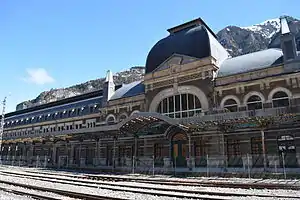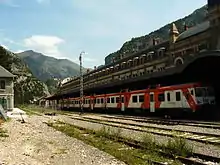Canfranc International railway station
Canfranc International railway station (Spanish: Estación Internacional de Canfranc) is a former international railway station in the village of Canfranc in the Spanish Pyrenees. The Somport railway tunnel, which carried the Pau–Canfranc railway under the Pyrenees into France, is located at one end of the station.
Canfranc | |
|---|---|
 The station building in July 2015 | |
| Location | Canfranc Spain |
| Coordinates | 42.75065°N 0.51460°W |
| Elevation | 1,195 metres (3,921 ft) |
| Line(s) |
|
| Construction | |
| Structure type | At-grade |
| History | |
| Opened | 11 July 1928 |
The station, which was opened during July 1928, was constructed on a grand scale to serve as a major hub for cross-border railway traffic. Its main building incorporates elaborate Beaux-Arts architecture, featuring 365 windows and 156 doors, along a length of 240 metres (790 ft). The station experienced numerous highs and lows, services having been temporarily interrupted by the intentional sealing of the Somport tunnel during the Spanish Civil War, while being extensively used by international traffic during the Second World War as the "Casablanca in the Pyrenees". The postwar era brought a period of stability and prosperity for the station and the line, although officials became increasingly pessimistic for its future during the 1960s. International services came to an abrupt end during 1970 following a train derailment that damaged a key bridge in France.
Canfranc station has remained open despite the international line's curtailment in 1970, but only being served by a handful of trains from the Spanish side alone. It has experienced a major decline and neglect, resulting in much of the site becoming derelict. The local government has ambitions to reopen the international line and to redevelop the station, which shall involve the renovation of the existing station building for use as a hotel and its replacement by a new facility. During February 2020, funding for both the relaunch of international services and the station's rehabilitation was made available by the European Union.
History
Origins
During the nineteenth century, two major border crossings were established between France and Spain.[1] However, even prior to the start of the twentieth century, it was recognised that there was consistently insufficient capacity to accommodate demand for cross-border traffic, and that a third border crossing was required. At one point, the cost of constructing such a crossing had been reportedly estimated at 3.2 million pesetas (roughly equivalent of €20,000 at the time), in addition to in excess of 1.2 million pesetas for supporting infrastructure such as access points, docks and other facilities.[1]
According to railway historian Alfonso Marco, Spanish officials found it desirable for such a railway to be provisioned with a grand station that would demonstrate the nation's engineering prowess, thus when such a project got underway, it was decided to build such a facility at the village of Canfranc, situated in a relatively undeveloped valley.[1] The practicality of building a grandiose station was the decision for the French and Spanish railway operators to share the facility, rather than having their own individual stations, which meant that Canfranc would serve as a prominent hub for the route, greatly shaping its design and scale.[1]
On 12 July 1912, construction work commenced on the Somport railway tunnel from the French side; it would be completed in 1915, the work having been delayed by the outbreak of First World War.[1] Construction of the station itself would not begin until 1923, headed by the Spanish project engineer Ramírez de Dampierre. It was formally opened on 18 July 1928, in the presence of King Alfonso XIII of Spain and the president of the French Republic Gaston Doumergue.[1]
Operational years
Roughly three years following its grand opening, Canfranc International railway station suffered a major fire; having started in the lobby, the blaze propagated throughout the adjacent areas, causing an estimated 500,000 pesetas in damages overall.[1] After this event, numerous officials lost their optimism in the value of the station.[1] During the Spanish Civil War, Nationalist leader Francisco Franco ordered the sealing of the tunnels on the Spanish side, allegedly to prevent arms smuggling.[2] However, as a consequence of the Franco-Spanish international convention under which it was built, the station itself remained open.[2]
During the Second World War, the station and the surrounding area acquired a reputation as the "Casablanca in the Pyrenees" due to it serving as a key crossing point for goods, as well as being the epicentre of espionage for Nazi and Spanish authorities.[1] Spain had formed an operational agreement with the Wehrmacht, which saw freight trains carrying mined tungsten northwards while French grain, as well as trans-shipped Swiss gold, was borne southwards. Passenger services also continued during the conflict, which provided an escape route into Spain for both Jews and Allied soldiers alike.[2] Aware of these movements, Nazi agents frequently sought to intervene against passengers of interest.[1]
Following the end of the war, railway traffic promptly returned to normality.[1] The relative stability experienced during the 1950s and 1960s brought about a period of prosperity, but this soon proved to be rather short-lived. In the 1960s, the future of both the station and the Pau-Canfranc railway became increasingly threatened, and they were chronically underfunded, leading to frequent incidents that eventually raised safety concerns.[1] The station is often said to have been used in the filming of Doctor Zhivago (1965), but although the film was shot largely in Spain, there is no evidence that Canfranc was a location.[3]
The station's principal purpose of operation came to an abrupt halt on 20 March 1970. A train derailment on the Pau-Canfranc railway line had demolished the L'Estanguet bridge on the French side of the Pyrénées Mountains. Under financial pressure from French national railway company SNCF, the French government decided not to rebuild the bridge, which effectively forced the closure of the cross-border line.[4] Despite this, the station remained open, served only by a handful of Spanish trains.[1] As a consequence of the through route's abrupt termination, the population of the village fell sharply over the following years.[2]
Present
_(1).jpg.webp)

Since the closure of the through route, much of the station and its facilities have been neglected and have become inoperative.[1] Large portions of the site have become overgrown, but the majority of the buildings have remained largely intact and can be entered. The main building has been re-roofed, but is otherwise in a state of disrepair, and thus is fenced off and remains closed to the general public outside of guided tours during July and August. Between 2013 and 2017, approximately 120,000 people, mostly Spaniards, toured the station, a greater number than had used the station when it was in service.[2]
During the 2010s, the railway station, using its more modest facilities, has been open for the twice daily passenger trains to and from Zaragoza-Delicias railway station,[2] plus the occasional freight train to the grain silo. During 2007, the station was declared to be a Site of Cultural Interest.[1]
The government of Aragon has long held various ambitions for the rehabilitation of the station.[1] Plans have been mooted to redevelop the main station building into a hotel, which would involve the construction of a new station beside it to replace it. There have been explorations of options to reopen the through line as the "western trans-Pyrenean line"; this initiative would reportedly involve the assistance of the government of Aquitaine, the adjacent French region.[2] In February 2020, it was announced that funding from the European Union had been made available for the purpose of reopening the through line and relaunching international services.[5][6]
Description
Canfranc International railway station was often referred to around the time of its opening as the "Titanic of the Mountains", in part due to its large size, being the second largest station in Europe at the time of its completion. Architecturally, it was deliberately designed with prominent symbolism: the exterior features an eclectic Beaux-Arts style that was reportedly inspired by French palatial architecture, while the interior was adorned with elements drawn from classical Roman architecture.[1] Large quantities of glass, cement and iron are present throughout the structure, which is adorned with 365 individual windows.[6]
The station's platforms have a length of 200 metres (220 yd).[2] Extensive infrastructure is present to service and transfer transiting passengers, baggage and freight between Spanish and French trains, because the French rail standard gauge of 1,435 millimetres (4 ft 8 1⁄2 in) was incompatible with the Spanish gauge of 1,668 millimetres (5 ft 5 21⁄32 in) at the time, and hence prevented through traffic.[7] This gauge complication transformed a routine customs-control exercise into a lengthy logistics exercise.
The site includes a large locomotive depot, two sheds for the transshipment of freight between French and Spanish trains, various other outbuildings and a resultant extensive layout of tracks.[2] There is also an array of underground passages running across the site, many of which remain accessible.[6] Part of the station was considered to be French territory; a school was established in the village for the children of its French staff.[2]
See also
References
- Berti, Adele (29 July 2020). "Canfranc: bringing an abandoned railway station back to life". railway-technology.com.
- Bockman, Chris (1 October 2017). "Is Europe's ghostliest train station about to rise again?". BBC News.
- Pedro Zapater (1 July 2012). "¿Se rodó 'Doctor Zhivago' en la estación de Canfranc?". Heraldo de Aragón (in Spanish).
- "27 mars 1970: l'accident" (in French). Quierzy Club. Archived from the original on 19 April 2005.
- "Reopening of the international railway line between Pau- Canfranc- Zaragoza". keep.eu. 24 June 2020.
- Martin, James Gabriel (6 October 2017). "Europe's most opulent abandoned railway station is being resurrected". lonelyplanet.com.
- Alberto García Álvarez (September 2010) [2009]. Automatic Track Gauge Changeover for Trains in Spain (PDF) (4th ed.). Fundación de los Ferrocarriles Espaňoles. ISBN 978-84-89649-56-9.
Bibliography
- Dieter Hamblock (2010). "Tristesse in den Pyrenäen" [Sadness in the Pyrenees]. Eisenbahngeschichte (in German). 40: 60–67.
- Alexander Kierdorf (2010). "'Es gibt keine Pyrenäen mehr' – Der Palastbahnhof im spanischen Canfranc" ['There are no more Pyrenees' — The Palace Station in Spanish Canfranc]. Industrie-Kultur (in German). 50 (1): 14–15.
External links
| Wikimedia Commons has media related to Canfranc train station. |
- "Canfranc railway station: in-depth history and pictures". Forbidden Places.
- "Canfranc railway station and Pau line photos and history". Pierre-Henry Muller.
- "Canfrancestacion.com" (in Spanish). Archived from the original on 4 January 2007.
- David Martos (12 October 2013). "Albert Le Lay, el espía que combatió a Hitler desde Canfranc" [Albert Le Lay, the spy who fought Hitler from Canfranc]. ABC (in Spanish). Retrieved 15 December 2013.
- Juego de espías (Canfranc-Zaragoza-San Sebastián) (2013) at IMDb
- El rey de Canfranc (2013) at IMDb
- "Pyrenees Crossing - Snow and Cognac". Berlin 1969.